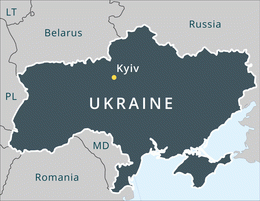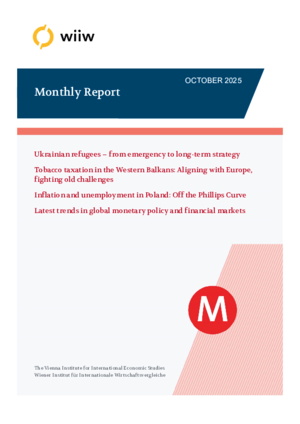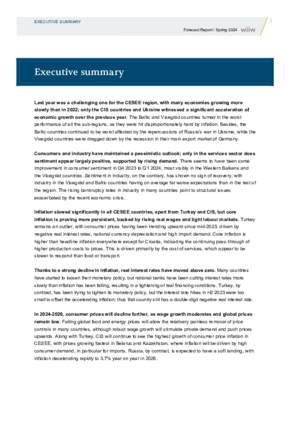Ukraine

| FORECAST* | ||||||
|---|---|---|---|---|---|---|
| Main Economic Indicators | 2022 | 2023 | 2024 | 2025 | 2026 | 2027 |
| Population, 1000 persons | 35000 | 36700 | 37000 | . | . | . |
| GDP, real change in % | -28.8 | 5.5 | 2.9 | 2.0 | 3.0 | 3.5 |
| GDP per capita (EUR at PPP) | 10200 | 11010 | 11330 | . | . | . |
| Gross industrial production, real change in % | -36.7 | 6.8 | 4.6 | . | . | . |
| Unemployment rate - LFS, in %, average | 25.0 | 20.0 | 14.0 | 12.0 | 10.0 | 9.0 |
| Average gross monthly wages, EUR | 437 | 441 | 494 | . | . | . |
| Consumer prices, % p.a. | 20.2 | 12.9 | 6.5 | 13.0 | 8.0 | 7.0 |
| Fiscal balance in % of GDP | -16.1 | -20.1 | -17.7 | -20.0 | -19.0 | -18.0 |
| Public debt in % of GDP | 77.8 | 83.3 | 91.2 | . | . | . |
| Current account in % of GDP | 4.9 | -5.3 | -7.9 | -13.1 | -13.8 | -14.0 |
| FDI inflow, EUR m | 210 | 4227 | 3712 | . | . | . |
| Gross external debt in % of GDP | 79.7 | 86.8 | 98.1 | . | . | . |
Basic data are continuously updated.
* Forecasts are changed beginning of January, April, July and November.
See Press Conferences.
Monthly Report No. 10/2025
Kristijan Fidanovski, Biljana Jovanovikj, Nóra Kungl, Leon Podkaminer and Maryna Tverdostup
wiiw Monthly Report No. 10, October 2025
42 pages including 10 Tables, 39 Figures
Executive summary
Olga Pindyuk
in: The Crisis is Over, but its Scarring Effects are Hindering Recovery
wiiw Forecast Report No. Spring 2024, April 2024 , pp. I-VII
Details

